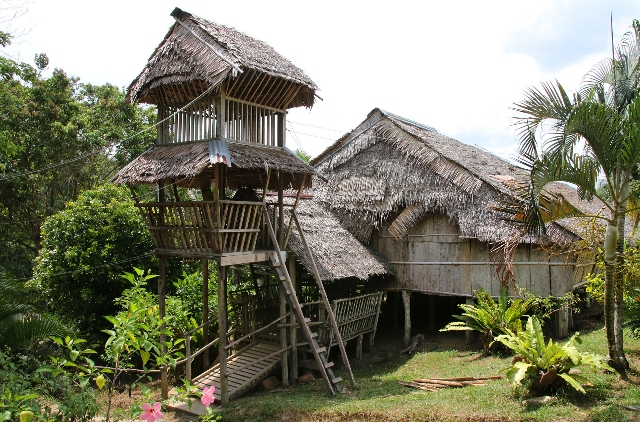To the Iban, the longhouse is not merely a home – it is a way of life. It is always built next to a river, which is both a transport route and a source of water. The size of a longhouse is calculated by the number of doors, or pintu, which can vary from half a dozen to almost a hundred, although the modern norm is around 20 plus. Each door is the entrance to an apartment or bilik with a combined living room and bedroom, a kitchen at the rear and an attic which is used to store rice. Opposite the bilik is a covered verandah, or ruai, which is used for ritual functions, making handicrafts, entertaining guests or just making handicrafts, entertaining guests or just relaxing with friends in the evening. Outside the ruai is an open verandah, the tanju, which is used for drying pepper and rubber.

A well-established, prosperous longhouse will be made of belian (ironwood) and other high quality hardwoods, and roofed with belian shingles or zinc sheeting. Pioneer longhouses in new areas are often made of bamboo and tree bark, with attap roofs. As the community becomes more established, the longhouse will gradually be improved and upgraded.
The construction of the Bidayuh longhouse is similar to that of the Iban, but without the external verandah. The Bidayuh are masters in the art of building with bamboo, using this strong and versatile material for building both their homes and their irrigation systems. Unlike the Iban longhouses, many Bidayuh longhouses are built at the foothills of remote mountains, a few hours walk from the nearest road or river. Therefore the individual rooms are often put together like a set of steps rising up the hillside.
The Bidayuh longhouse is also largely democratic, with all members having a say in the running of the community, but the headman is generally chosen from amongst the sons of the former headman. However, only a small minority of Bidayuh still live in longhouses, most preferring the open space and relative freedom of the village or kampung.
Orang Ulu longhouses are broadly similar to those of the Iban in construction, although they are often larger, and may frequently possess two stories. They are far more ornately decorated than those of the Iban and Bidayuh, and feature large ‘tree-of-life’ murals and ornate woodcarving and detailing.
Unlike the Iban, the Orang Ulu tribes are hierarchical, with a class of traditional aristocrats known as maren. The tuai rumah and his family will live in a very large apartment at the centre of the longhouse, surrounded on either side by their aristocratic neighbours, whilst the commoners live further away from the centre. Social status was traditionally determined by a person’s distance from the tuai rumah’s apartment, although nowadays this distinction is becoming less important in everyday life.
Visitors to Orang Ulu longhouses, particularly those of the dominant Kayan and Kenyah, cannot fail to be impressed by the artistic and musical talents of the people. Many Orang Ulu are master woodcarvers, producing superb statues, masks and klirieng (burial poles) from tough jungle hardwoods. Most spectacular are the guardian figures that use the aso or dog motif. The longhouse are frequently brightly decorated with large murals rendered in the traditional “tree of life” style. Orang Ulu women produce beautiful beadwork, with which they adorn everything from sun-hats to baby-carriers.
The Bavaggazo longhouses are unique attractions for visitors as they were planned and developed as a cultural centerpiece by the Rungus community at kampung Bavaggazo.
The Rungus marketed the longhouses as a means to display and conserve their culture heritage whilst engaging in an economically sustainable venture.
Kampung Bavanggazo is an ideal example of a successful community tourism project operated by the indigenous community of a particular region.
The two Bavanggazo longhouses each took about eight months to build. There are ten sirang in each longhouse. Nearby are two sulap which are traditional paddy atores. Located a few feet away are the village’s only modern amenities, toilets and showers equipped with tapped water from the hills.
The Labi longhouses in Brunei, is further down the Labi Road, past Kampong Labi itself, there are several examples of a form of dwelling unique to Borneo – the longhouse. A village under one roof, longhouses consist of a row of family houses – r doors – with a communal area running the length of the building. This is the social centre of the village.
Rampayoh longhouse has 16 doors and is the nearest to Labi. Others include Mendaram Besar, Mendaram Kecil and, at the end of the road, Teraja. They are populated by Iban folk – once feared as headhunters but now more given to pastoral activities. Visitors are always warmly welcomed. Etiquette requires that you take some small gifts, ask permission before entering and remove footwear before doing so.
Several trails head off into the jungle along this stretch of the road. They are clearly sign posted and marked, and lead the walker to scenic waterfalls and hills in virgin primary forest. They are relatively undemanding and guides are not necessary, but for your own safety you are advised to seek local advice before setting off.
 Longhouses? Please Vote!
Longhouses? Please Vote!


